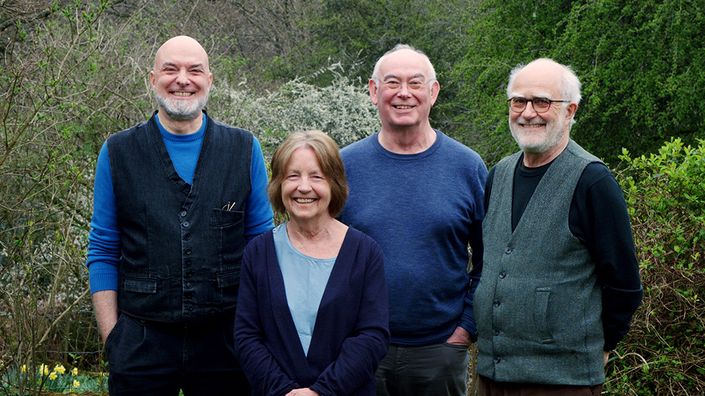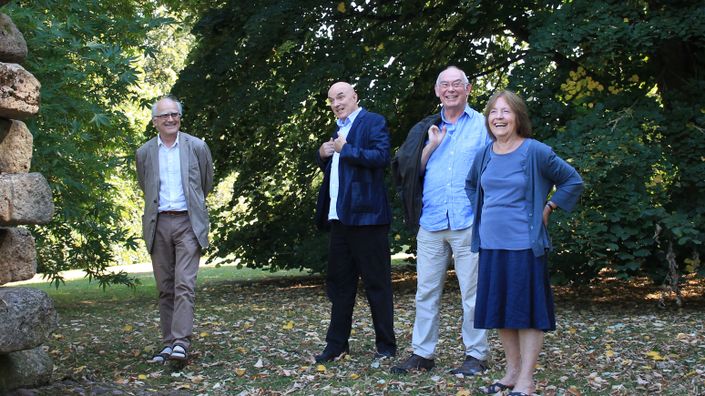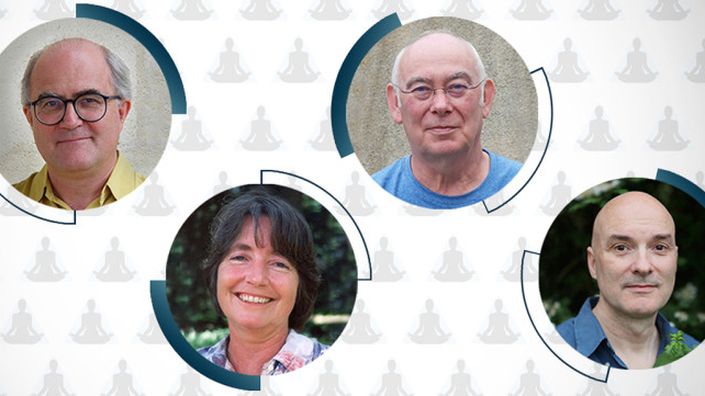The Spiral to Freedom
How Dependent Arising Leads to Nibbana
Join Akincano Weber and John Peacock
as they uncover a profound Buddhist teaching
that has been hiding in plain sight.
What Is the Spiral to Freedom?
Around 16 Buddhist discourses describe a pattern of wholesome qualities that build upon each other. These qualities create a path that spirals upwards toward spiritual and psychological freedom. We call these discourses the spiral texts. They are not hidden but somehow Buddhist traditions have overlooked them.

Progress at your own pace
This easy-to-use online course is available to all. It comprises six units that form a program of instruction, meditation, discussion, and contemplative exercises. Each unit contains around 60 minutes of material to view and practice. There is also the opportunity to cultivate the spiral to freedom in your daily life. You are free to progress at your own pace, and will retain ongoing access to the material.
Join today to begin the course! Two Zoom Q&A sessions will be offered with John and Akincano on July 26 and August 16 at 6pm UK time.

The Spiral to Freedom
The following diagram shows the stages of the spiral to freedom, starting at the bottom and spiralling upwards. Here we see the varying structures of the spiral texts superimposed upon each other. What stands out clearly is their common core: the spiral from gladdening to gathering the mind. The texts tell us that there are many ways to enter this spiral, and many fruits from its cultivation.
This is the path you will cultivate in this course, under the guidance of Akincano Weber and John Peacock.
Suffering, distress, the painful
(dukkha)
The spiral to freedom includes the messiness, uncertainty, and grief of our lives as a starting condition. We may notice that this is the end-point of the traditional 12-link model of dependent arising.
Confidence / trust (saddhā)
Care, heedfulness, dedication (appamattassa vihāra)
Restraint (samvara)
Virtue / ethics (sīla)
Inspiration (atthapatisamvedī)
Mindfulness & situational awareness (satisampajaññā)
Wise investigation (yoniso manasikāra)
(pāmojja)
(pīti)
(passaddhi)
(sukha)
(samādhi)
(viraga, nibbida)
The spiral leads to a certain coolness and equanimity which becomes the basis for a variety of fruitions...
(āsavakkhayañāna)
(dhammānaṃ pātubhāva)
(vimutti)
(yathābhūtam jānāti passati)
(vimuttiñāṇadassana sacchikaroti)
(anuttara yogakkhema)
Benefits

A path for everyone
The spiral to freedom is a progression that starts amidst the struggles, joys, and disappointments of everyday life. In fact, there are different entry points into the spiral that will suit different practitioners. This course is suitable for beginners and experienced meditators alike.

Study with founding members of Bodhi College
Akincano Weber and John Peacock are founding faculty members of Bodhi College. Bodhi College is an educational charity offering contemplative programs for contemporary life.

No previous experience necessary
There is no requirement to have studied any previous course or have prior knowledge of this topic. This course contains everything you need to start walking the spiral path.

All Buddhist terms explained
This is a practical course about putting the spiral teachings to use in our lives. Sometimes it's useful to know a little ancient Buddhist terminology but all such terms are explained with helpful definitions wherever they occur.

Stimulating discussions
See John and Akincano bounce ideas off each other as they map terrain which has been relatively unexplored by Buddhist traditions.

Take the course with you
You don't need to be sitting at a computer to take this course. You can use a tablet or phone, or even download the audio files and a printable workbook and head off into nature or to a café.
Curriculum
Meet Akincano and John

Akincano Weber
Akincano M. Weber is a European Buddhist teacher and contemplative psychotherapist (MA). A former monk, he has lived and practised for 20 years in European and Thai Forest monasteries. Today he is the guiding teacher of Atammaya Cologne, co-founder of Bodhi College and part of several dharma and mindfulness teacher training programmes. He has been teaching meditation and Buddhist Psychology in secular and traditional contexts in Europe and overseas for many years and lives with his partner in the Rhineland, Germany.
Akincano has a particular interest in contemplative psychology, the practice of stillness, and the cultural translation of the wisdom teachings of early Buddhism for people of today.

John Peacock
John Peacock is a retired academic and a Buddhist practitioner for over fifty years. He initially trained in the Tibetan Gelugpa tradition in India and subsequently studied Theravada in Sri Lanka. He lectured in philosophy at the University of Manchester, Buddhist Studies at the University of Bristol and finally became co-director of the Masters degree in Mindfulness-based Cognitive Therapy at the University of Oxford. John has been teaching meditation for over thirty years and continues to research and teach the similarities and differences between early Greek thought and practice, existentialism and early Buddhism. He has a particular focus on ethics within all of these different approaches.
Testimonials
Praise for The Spiral to Freedom, featuring Akincano Weber and John Peacock
Great course for all practitioners. Best one I have taken and I have been practicing for 20+ years. I will revisit many times because the course is so rich with ideas and techniques.
A very practical, empowering teaching, makes even 'advanced' meditation states like rapture, tranquility, and samādhi accessible along with deeper insight into the dhamma.
The course seems to break new ground in its emphasis on life-affirming ways of studying and living the dharma, as well as bringing some clear suggestions on how to live Buddhist ethics in our rather scary and cynicism-prone modern times.

About Bodhi College
The aim of Bodhi College is to develop fresh ways of understanding the dharma today through rediscovering the core insights of early Buddhist teachings. Courses provide a contemplative education that inspires students to realize the values of the dharma (Buddhist teachings) in the context of this secular age and culture.
In the spirit of the Buddha’s teaching, Bodhi College is committed to a middle way of human awakening that integrates theory with practice, encouraging both personal fulfillment and social engagement.
Related courses
You may also be interested in these Tricycle Online Courses.



